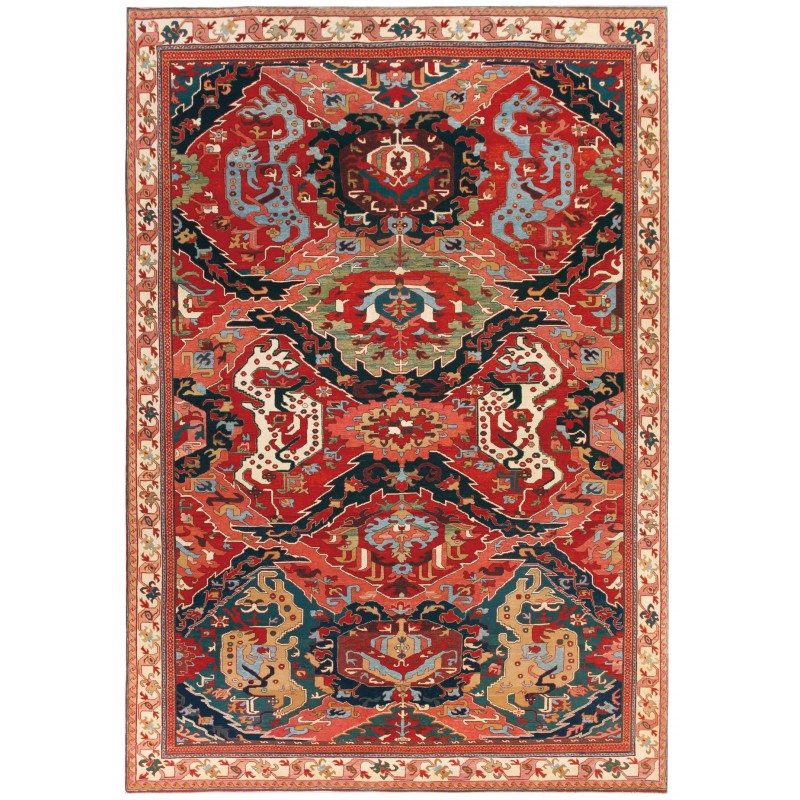
- Stock: In Stock
- Model: C40068
- サイズ: 255cm x 372cm
- SKU: ART44
この絨毯の情報は、E. Heinrich Kirchheimによる著書『Orient Star – A Carpet Collection』(Hali Publications Ltd、1993年、nr.57)からのものです。ドラゴンの象徴とその絨毯への描写には長い間魅了されてきました。『ドラゴン』絨毯のデザインは、尖ったギザギザの葉から成る重ねられた異なる色の格子柄から構成され、交差するひし形の中には交互にパルメットが配置され、対面するようにスタイライズされたドラゴン、鳥、または動物の図柄が並びます。最も古くからある『ドラゴン』絨毯の中には、比較的自然主義的に描かれた鳥や走る動物と共に単独または対面するペアとして立っているドラゴンのモチーフが含まれています。グラフ絨毯はもともとダマスカスのモスクで発見され、現在はイスラミッシェス・ミュージアム(ベルリン)に所蔵されており、このタイプの最古の例とされています(Serare Yetkin, Early Caucasian Carpets in Turkey, Vol. II, London, 1978, p.8, fig.118を参照)。Yetkinは『ドラゴン』絨毯を「アーキエイク」「フォー・ドラゴン」「ドラゴン・アンド・フェニックス」の4つのタイプに分類しており、現在の絨毯は「ドラゴン・アンド・フェニックス」グループに属しています。他の例としては、ハンブルクのMuseum fur Kunst und Gerwerbeにある2つの断片、エステルゴムのChristian Museumにある別の断片、Kierコレクションの完全な絨毯、ワシントンD.CのTextile Museumの不完全な例、ルガーノのThyssen-Bornemiszaコレクションの「Cassirer」ドラゴン絨毯、トカトのAli Pasa Mosqueの絨毯、イスタンブールのVakiflar Hali Museumのさらなる例が挙げられます(S. Yetkin, op.cit. pp.16-20)。カフカースの「ドラゴン」絨毯の最も初期の例は、織物の幅においてより多くのリピートが見られるとされています。また、偶然にも現在の絨毯と同じく、16世紀末から17世紀初頭には動物の闘いのグループが人気のモチーフとして現れ、ペルシャの絵画や書籍の装丁、そしてサファヴィ朝宮廷の壮大な絨毯にも見られます。17世紀から18世紀初頭の古典的なカフカースの絨毯の多くは、17世紀の「ヴァーズ」絨毯に遡ることができます。これらの絨毯で使用される格子柄は「ヴァーズ」絨毯の格子柄に関連していますが、早い段階の『ドラゴン』絨毯では、ギザギザのパネルの着色により、格子の重ね合わせのプレイが失われています。この絨毯のデザインは、私たちのデザイナーによって解釈され、オリジナルに合った鮮やかな色彩が使用されています。
The source of the rug comes from the book Orient Star – A Carpet Collection, E. Heinrich Kirchheim, Hali Publications Ltd, 1993 nr.57. There has long been a fascination with the symbolism of the dragon and its depiction in carpet weavings. The design of ‘Dragon’ carpets consists of a field pattern composed of different colored overlaid lattices formed of pointed, serrated leaves creating intersecting lozenges, which alternately contain palmettes and are flanked by confronting stylized dragons, birds, or animal figures. The most archaic of the ‘Dragon’ carpets include dragon motifs with birds and running animals that are relatively naturalistically drawn, which stand either alone or in confronting pairs facing a tree. The Graf carpet, originally found in a Damascene mosque, now in the Islamiches Museum, Berlin, is considered to be the oldest example of this type, see Serare Yetkin, Early Caucasian Carpets in Turkey, Vol. II, London, 1978, p.8, fig.118. Yetkin defines four types of ‘Dragon’ carpet: ‘Archaic’, ‘Four-Dragon’, ‘Dragon-and-Phoenix’ and as a further combined development of the latter, the ‘Two-Dragon’ style, of which the present carpet falls into the ‘Dragon-and-Phoenix’ group along with other examples, some of which include two fragments, one in the Museum fur Kunst und Gerwerbe, Hamburg; another in the Christian Museum, Esztergom, Hungary, a complete carpet in the Kier collection; an incomplete example in the Textile Museum, Washington, D.C; the ‘Cassirer’ Dragon carpet in the Thyssen-Bornemisza collection, Lugano; the Ali Pasa Mosque carpet in Tokat, and a further example in the Vakiflar Hali Museum, Istanbul (S. Yetkin, op.cit. pp.16-20). It has been suggested that the earliest examples of the Caucasian ‘Dragon’ carpets have a greater number of repeats across the width of the weaving than in later pieces. An example of a ‘Four-Dragon’ carpet, also coincidentally from the collection of Charles Deering as the present carpet, was sold in Sotheby’s, New York, 27 September 2000, lot 35.
Animal combat groups were popular motifs in the late 16th and early 17th century, appearing in Persian paintings, book covers, and of course within the magnificent carpets of the Safavid court, from which it is probable that Caucasian ‘Dragon’ carpets were modeled (Duncan Haldane, Islamic Bookbindings in the Victoria and Albert Museum, London, 1983, no.106, pp.110-111, for example). Many of the classical Caucasian carpets of the 17th and early 18th centuries can be traced back to the ‘Vase’ carpets of the 17th century. The lattice used in these carpets itself relates to the lattice of ‘Vase’ carpets (Ellis, op. cit, pp.12-13), but already in the present early ‘Dragon’ carpet, the coloring of the serrated panels means that the overlay play of the lattice has been lost. The design of this rug is interpreted and vivid colors are chosen by our designers for this rug.
